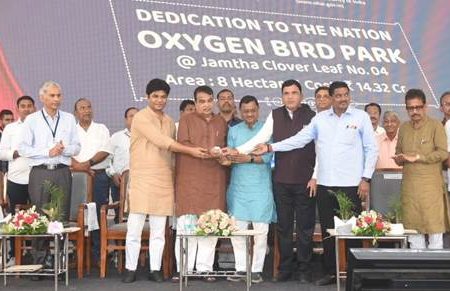Nagpur: Minister of Road Transport and Highways, Nitin Gadkari, inaugurated the much-anticipated Oxygen Bird Park (Amrit Mahotsav Park) today, located along the Nagpur-Hyderabad National Highway-44 near Jamtha in Nagpur, Maharashtra. This eco-friendly initiative, developed by the National Highways Authority of India (NHAI), spans 8.23 hectares and is designed to serve as both a natural bird habitat and a recreational space for locals and tourists.
The Oxygen Bird Park, approved in March 2023 with a development cost of ₹14.31 crore, integrates environmental sustainability with public recreation. Of the total area, 2.5 hectares are dedicated to social forestry, enhancing the ecological balance in the region. Gadkari shared that the idea for the park originated from his suggestion to develop a green space along NHAI land to observe the variety of birds found in Central India and create a recreational spot for citizens.
A Green Oasis for Birds and People
The park is strategically located at the Clover Leaf intersection near the Jamtha International Cricket Stadium and is part of a larger infrastructure project—a four-lane standalone ring road around Nagpur city. Gadkari emphasized the park’s dual role as a conservation site for local and migratory bird species and a place for citizens to connect with nature. “The park is designed to mimic natural ecosystems, providing a sanctuary for birds while offering a peaceful retreat for people,” he said during the inauguration.
Ecological Features of Oxygen Bird Park
The park is divided into various sections, each designed to support biodiversity and promote ecological sustainability:
- Rare and Endangered Trees Area: Showcasing species native to Central India, this section will feature trees like the Vulnerable Indian Bael, Gum Karaya, and the Endangered Yellow Flame of the Forest, helping preserve these species.
- Lotus/Lily Pad Pond: This pond will create a habitat for water birds and help recharge groundwater. It also holds the potential to attract both resident and migratory ducks, offering a serene aquatic ecosystem.
- Reed Bed: Positioned near the pond, the reed bed will serve as a refuge for birds like waterhens, moorhens, and reed warblers, particularly during migration seasons.
- Bambusetum: Native bamboo species will help reduce dust, absorb vehicle emissions, and improve soil quality, contributing to the park’s green belt.
- Plantation Area: Extending beyond the core park, this area will feature native trees and shrubs, promoting wildlife and enhancing air quality by mimicking a natural forest setting.
- Palm Plantation: Located behind the lake, this area will include native Indian palms, providing nesting sites for birds like hornbills and weaver birds.
The park’s diverse flora, including species like Neem, Indian Coral Tree, Lotus, and Wild Jasmine, is specifically chosen to support local wildlife and foster biodiversity.
Visitor Infrastructure and Amenities
In addition to its ecological focus, Oxygen Bird Park offers modern visitor amenities. Facilities include a ticket counter, food court, modern toilets, jogging and cycling tracks, an amphitheatre, watchtowers, and cast-iron benches. The park’s landscaping features expansive lawns and green pockets, while a 200 kVA transformer and additional borewells ensure sustainable utilities.
Gadkari emphasized the park’s role in not only enhancing biodiversity but also providing a healthy recreational space for the community. “This initiative is a step towards building greener highways and fostering harmony between infrastructure development and environmental conservation,” he concluded.

